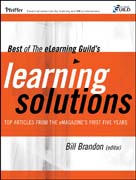
Best of the eLearning guild's learning solutions: top articles from the eMagazine's first five years
Brandon, Bill
The Best of eLearning Guild offers a unique approach to the topic as it covers three different, yet often intertwined, approaches to eLearning: Strategy and Management, Capturing Skills and Knowledge, and Facilitating Skill and Knowledge Transfer. The book covers the most common technologies, such as authoringtools, XML, and storyboarding as well as the more cutting-edge technologies such as mobile eLearning and reusable learning objects. In addition, there willbe a companion webpage, on which customers will find never-before-published tips, tricks, and techniques from several of the contributors, keeping the bookup-to-date well after the first reading. INDICE: Foreword by David Holcombe. Acknowledgments. Introduction. SECTION1: e-LEARNING STRATEGY AND MANAGEMENT. Chapter 1: If You Only Look Under the Street Lamps or Nine e-Learning Myths (Lance Dublin). Chapter 2. High Attrition Rates in e-Learning: Challenges, Predictors, and Solutions (Margaret Martinez). Chapter 3. Learning Measurement: It's Not How Much You Train, But How Well(Jeffrey Berk). Chapter 4. The XML e-Learning Revolution: Is Your Production Model Holding You Back (Doug Wallace and Anthony Levinson). Chapter 5. Integration of e-Learning and Knowledge Management (Desiree Tryloff and Victoria Bowen). Chapter 6. The Design Document: Your Blueprint for e-Learning Standards and Consistency (Monique Donahue). Chapter 7. Steps to Creating a Content Strategy for Your Organization (Ellen Wagner). SECTION 2: CAPTURING SKILL AND KNOWLEDGE. Chapter 8. Back to the Basics: Revisiting Great Training on Behalf of Great e-Learning (Allison Rossett). Chapter 9. Evolution of an e-Learning Developers Guide: Documenting Decisions and Intentions (Mike Dickinson). Chapter 10. Evolution of an e-Learning Developers Guide: Instructional Design and Project Management (Mike Dickinson). Chapter 11. Using Microsoft Word for Rapid Storyboard Development: Efficient Production of Professional e-Learning Storyboards (Cynthia Holmes-Radner). Chapter 12. The New Frontier of Learning Object Design (Ellen Wagner). Chapter 13. Avoiding Assessment Mistakes That Compromise Competence and Quality (Patti Shank). Chapter 14. Templates, Reusability, Future-Proofing, and the Technology Side of Rapid e-Learning (Kendrick Abell). Chapter 15. A Team of One: Rapid e-Learning Environment at Break-Neck Speed (Stephanie R. Sanford). SECTION 3: FACILITATING SKILL AND KNOWLEDGE TRANSFER. Chapter 16. Six Principles of Effective e-Learning: What Works and Why (Ruth Clark). Chapter 17. Bridging the Formal-Informal Gap: Blended Learning Evolves (Clive Shepherd). Chapter 18. Behind the Screens: A Look at The eLearning Guild's Online Forum Series (Karen Hyder). Chapter 19. Fast Track Your e-Learning Video Development: Targeting Production Needs Analysis (Laura Levy). Chapter 20. Simulations and Games: Revisiting Their Strategic Value (Allison Rossett). Chapter 21. Be Constructive: Blogs, Podcasts, and Wikis as Constructivist Learning Tools (Joyce Seitzinger). Chapter 22. Using Radio Production Techniques to Improve Synchronous Communication (Marc Gamble). Index. About the Editors.
- ISBN: 978-0-470-23962-9
- Editorial: John Wiley & Sons
- Encuadernacion: Rústica
- Páginas: 416
- Fecha Publicación: 23/04/2008
- Nº Volúmenes: 1
- Idioma: Inglés
